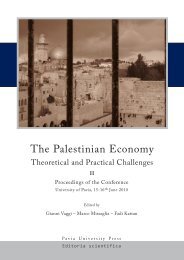Musica che affronta il silenzio - Scritti su Toru Takemitsu - Pavia ...
Musica che affronta il silenzio - Scritti su Toru Takemitsu - Pavia ...
Musica che affronta il silenzio - Scritti su Toru Takemitsu - Pavia ...
Create successful ePaper yourself
Turn your PDF publications into a flip-book with our unique Google optimized e-Paper software.
Nature and the Art of S<strong>il</strong>ence in Tru Takemit<strong>su</strong><br />
Giangiorgio Pasqualotto<br />
I wish to begin by <strong>il</strong>lustrating the title of this essay. The ideas of nature and s<strong>il</strong>ence which<br />
underlie the music of Takemit<strong>su</strong>, as indeed that of other Japanese composers, are profoundly<br />
different to what we might imagine. The concept of nature does not correspond to a<br />
thing, to one enormous ‘object’ or agglomeration of objects outside or confronting the individual<br />
as if it were an antagonist or a backcloth to be animated and exploited. Rather, nature<br />
is seen as a horizon which includes us and <strong>su</strong>rrounds us constantly; it is a sort of receptacle.<br />
In fact the Japanese term for it, ‘mother’s v<strong>il</strong>lage’, views it as a reality which encompasses<br />
us before we are born, throughout our lifetime and after our death. Nature is much more<br />
significant than the looming ‘wall’ we tend to vi<strong>su</strong>alise in the West, confronting us with<br />
natural disasters. Moreover this is all bound up with the enormous problem of technology,<br />
which I cannot go into here.<br />
This very different conception of nature is evident in the teachings of Shint, the traditional<br />
Japanese autochthonous religion. Commonly defined as ‘polytheistic naturalism’,<br />
at the deepest level Shintoism represents an authentic adoration not only of the objects of<br />
nature, meaning trees, earth, water, but also natural phenomena, <strong>su</strong>ch as the waterfall, often<br />
framed by a tori or portal, constituting the sancta sanctorum in a temple. One can also<br />
think of the configuration of the greatest Shintoist temples <strong>su</strong>ch as Ise or Izumo. 1<br />
As for s<strong>il</strong>ence, I can recall the very important concept ma, which is none other than a<br />
specific manifestation of a much more comprehensive s<strong>il</strong>ence. Ma is an interval between two<br />
sounds, but it is like the tip of an iceberg which for all its diminutive size contains everything:<br />
it represents the underlay of all the sounds and notes, the natural or man-made noises, which<br />
we hear. Once again s<strong>il</strong>ence is not the opposite of sound or noise but rather the receptacle, the<br />
matrix for all aural manifestations.<br />
1 For centuries the major Shintoist temples have been bu<strong>il</strong>t in the same way, entirely in wood and blending<br />
harmoniously into nature so that the whole entity, the bu<strong>il</strong>ding and its natural environment, becomes the temple.

















